From the February 2023 issue of Apollo. Preview and subscribe here.
It’s an unsettling experience to walk into a room in a house that you’ve never visited, owned by a person you’ve never met and to feel as if you know it intimately – not just visually, but physically. Thousands of people have visited Franco-Algerian artist Zineb Sedira’s ‘living room’, which formed one part of her theatrical installation inside the French Pavilion at the Venice Biennale in 2022. She was the first artist of Algerian descent to represent France and within hours of the exhibition opening, she was pegged as a favourite for the top award. In the end her friend and south London neighbour, Sonia Boyce, who also appears in Sedira’s film Dreams Have No Titles, the central piece in the pavilion, took home the Golden Lion. For Sedira, however, the project was never about winning, it was about ‘friendship, solidarity and the artistic community’.
The living room replica is now at the Hamburger Bahnhof (until 30 July) while we are meeting in the ‘real’ version, in her house in Brixton. The sofa is different, I notice, as Sedira gestures for me to sit and then goes about switching on lamps before settling into a wicker chair amid a cluster of dark green leafy plants. In a gold-belted embroidered waistcoat, her eyes accentuated by dark flicks of liquid eyeliner, she suits the 1960s-inspired setting perfectly. Having recently closed her studio in London, Sedira has been conducting all of her meetings in her living room, further blurring the boundaries between private and public, art and life. It’s a necessity rather than an artistic act, but I suspect she enjoys the air of anticipation and the uncertainty it causes.
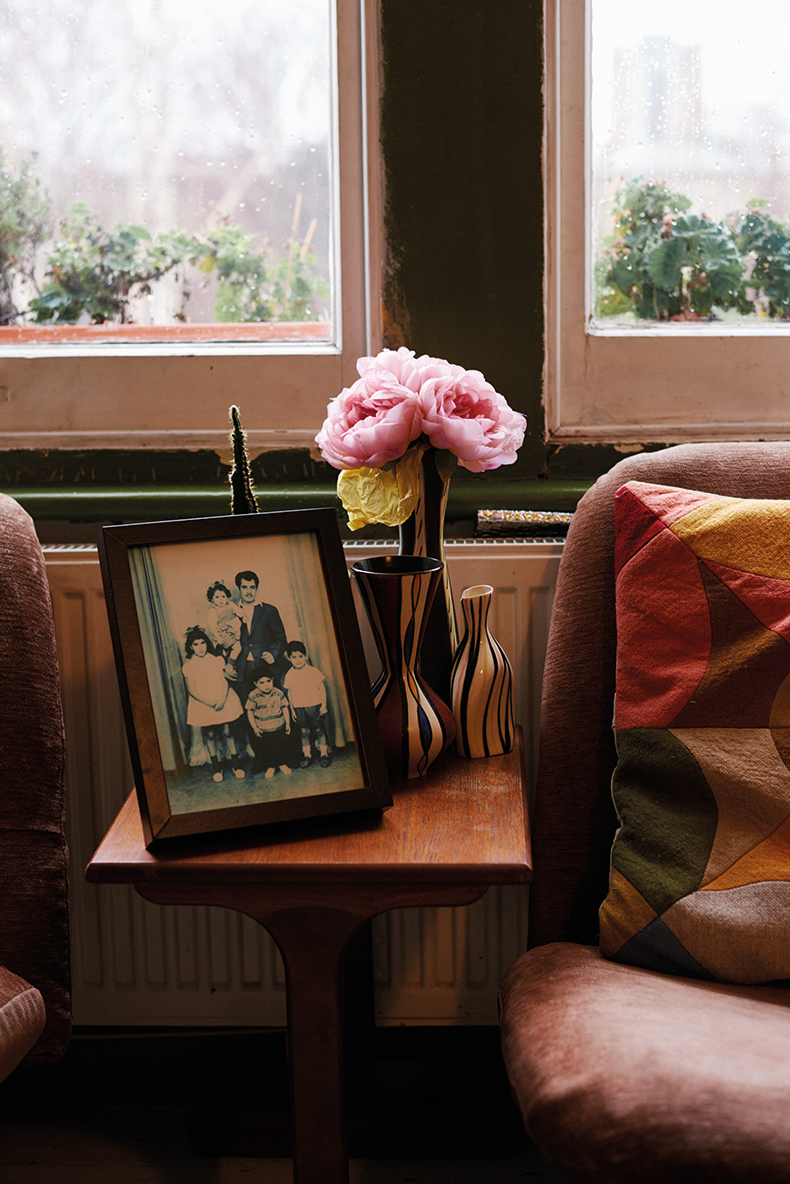
The ‘real’ version of Zineb Sedira’s living room in south London. Photo: Toby Coulson
Sedira was born in the Parisian suburb of Gennevilliers – one of nine children of working-class Algerian parents who moved to France not long after Algeria gained independence in 1962. In 2003, she made a three-screen video installation called Mother, Father and I in which she interviews her parents about their involvement in the war (they were ‘freedom fighters’), their passage to France and the hatred they faced. Like many of her early works, the footage feels raw and unpolished. Her father sits with his arm resting on a kitchen table as he speaks in Arabic about witnessing soldiers carrying people off to barracks in Vincennes, ‘trampling them, beating them, killing them’.
‘Right from the start of my career I’ve worked with my personal life, my parents’ life,’ Sedira says. ‘For me, it was the best way to talk about politics – it made it more accessible to include myself or someone else’s personal story.’ For her first exhibition in 1997, after graduating from Central Saint Martins and the Slade School of Fine Art, she covered the walls of the Gallery of Modern Art in Glasgow with geometric patterned wallpaper with images of four generations of women in her family, including herself, incorporated into the designs. This was followed by one of her first video works, Don’t do to her what you did to me (1998/2001), in which photographs of a woman are torn up and stirred into water until they disintegrate, in a reinterpretation of a ritual where phrases from the Qur’an are dissolved. The film remains one of her most direct and disturbing works to date. It was shown in the group exhibition ‘Authentic/ExCentric: Africa In and Out of Africa’ at the Venice Biennale in 2001 and then again in Sedira’s solo exhibition at the Jeu de Paume in Paris in 2019. There have been many other references to historical violence and erasure in her work since then, but they are more often alluded to than re-enacted. Shattered Carcasses and Architecture of the Forsaken (2009) comprises a photographic series of the wreckages in a boat graveyard in Mauritania, the starting point for migrants hoping to undertake the perilous journey from Africa to Europe. Meanwhile, the installation The Forgotten [Condemned] Journalists of Algeria’s Black Decade (2018) lists nearly 100 journalists who disappeared, were threatened or killed during the Algerian Civil War between 1993 and 1997.
Sedira, however, is not interested in actively pointing fingers and, besides, she doesn’t see herself as an activist: ‘For me, activists have to be serious. You have to be quite didactic somehow. I can be serious, but I enjoy work that uses humour – laughter as a weapon or a tool to resist.’ In her installation Laughter in Hell (2014–18) the comic becomes an important means of relief and expression. The display of political cartoons and caricatures that Sedira has collected from the ‘Black Decade’ include rare publications dedicated to cartoonists such as Ali Dilem.
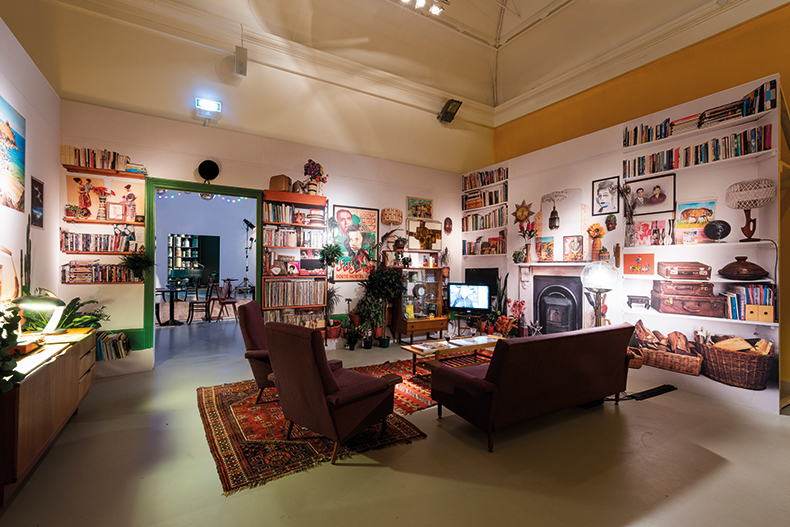
Dreams Have No Titles (2022), Zineb Sedira, installation view of the 59th International Art Exhibition at the Venice Biennale. Photo: Thierry Bal/Zineb Sedira; courtesy the artist and kamel mennour, Paris; © Zineb Sedira/Adagp, Paris, 2022
While she was preparing for the exhibition at Jeu de Paume, Sedira had the idea of something more playful, of staging an environment such as her living room. She had been researching ‘the anticolonial era of the Global South’, with a focus on the Pan-African Festival of Algiers in 1969. At that time, Algeria was still struggling to rebuild itself but, as much of the population was illiterate, Sedira explains, visual culture and especially cinema was extremely important. The festival brought together artists, writers and thinkers from all across the continent to discuss and show their work.
‘For me, the living room became like a microcosm of the festival,’ Sedira says. ‘In the living room, you dance, you drink, you sing, you raise your kids, you chat with friends. It’s a joyful space and it can be a sad space too. [The work] is also very personal: it has photos of my kids, my parents, a stain on the sofa – it traces the life that we’ve lived in there.’ The recreation, complete with the original, orange stain-bearing sofa serves as a document of time, but also as a performance of identity – ‘we tried to make it as close as possible to reality, but it’s like films and documentaries, it’s never the real thing’ – and a stage. Visitors can walk around as well as within the space and see the wooden scaffolding holding up the walls – in Venice, it was also possible to glimpse further sets for different environments through the doorway including a green screen with a miniature maquette of the living room with cut-outs of the artist. Sedira has always been ‘fascinated by the relationship between fiction and reality’ and by creating a slippage between them.
Sedira visited Algeria several times as a child, but when she began to make art in the early 1990s, it was the time of the civil war and it was no longer possible to travel there. As such, her vision of and relationship to Algeria were shaped by her early memories and imagination as well as secondary sources – largely the family’s photographs and stories. In 2002, she made a three-channel video work titled Mother Tongue in which she, her mother and daughter attempt to exchange their childhood memories in their native languages: French, Arabic and English. Then in 2004, she was invited to do a project in Algeria and her focus switched from interviewing people to documenting the land and the sea.
‘People have often asked me why I stopped doing biographical work at that point, but the way I see it, I just changed the approach, the metaphor,’ she says, pointing out that in French the word for sea (la mer) is sonically the same as the word for mother (la mère). In a sense, this period was a homecoming: she was getting to know the country of her ancestors through the lens of her camera. Her solo exhibition ‘Can’t You See the Sea Changing?’, – staged at the De La Warr Pavilion last year and now travelling to Dundee Contemporary Arts (29 April–6 August) – comprises a series of works related to the sea, created between 2008 and the present day, that demonstrate how she came to fuse the intimacy of her early family-based works with a cinematic documentation of place.
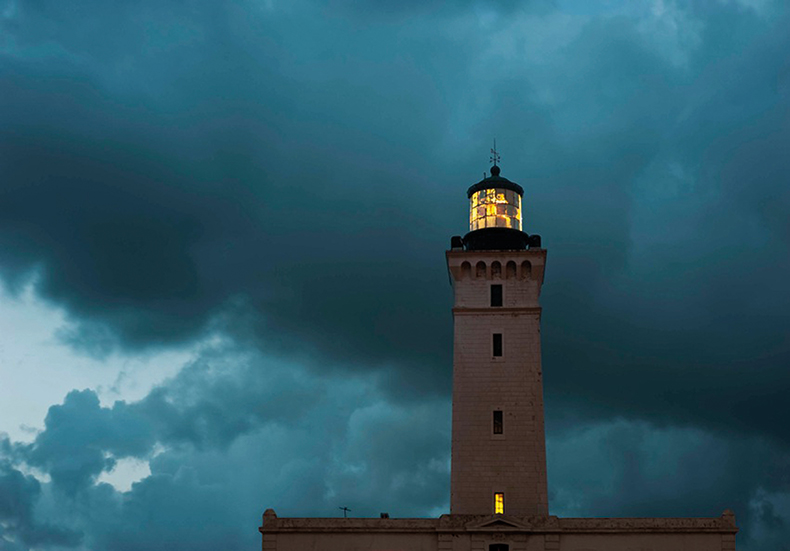
Cap Caxine 1869 (2011), Zineb Sedira. Courtesy the artist and kammel mennour; © Zineb Sedira/DACS, London
In Lighthouse in the Sea of Time (2011), she records two lighthouses in Algiers – Cap Sigli and Cap Caxine – that were built under French colonial rule. Jutting out from the cliffs’ edges, the heavy, masculine structures serve as symbols of a painful past, but under Sedira’s gaze and filtered through the soft aesthetic of 16mm film, they also become sites of work and pleasure. We watch hands rubbing the glass of the lamp clean, golden light filling a stairwell; we hear the mechanical whirr of the light turning, the deep bellowing call of a passing boat and the persistent roll of waves that spray white foam into the air and then retreat, sending rivulets of water running down the rocks. In an accompanying film, the keeper of one of the lighthouses speaks into the camera, his eyes creasing as he smiles shyly, ‘For me, it’s paradise – really.’
Although Sedira is physically absent from these works, it’s impossible not to feel the artist’s presence through the camera and in this way, she challenges the traditionally detached style of documentary. ‘I can only work with somebody I love,’ she admits, ‘or I suppose it’s the story because I don’t know the real life of the lighthouse keeper but for that moment, when I am with him and he tells me the story, I fall in love and through that the work can only be beautiful.’ But if there is an element of romanticism in Sedira’s work, it is connected more to hope than idealisation; falling in love is a kind of freedom.
This was, essentially, the idea governing Sedira’s presentation at the Venice Biennale for which she built not only a recreation of her living room but also a series of working film sets inspired by her research into the archives at the Cinémathèque d’Algérienne and the wider production of activist films during the 1960s and ’70s. Established in 1965, the cinémathèque became an important site of cultural learning and collaboration in Algiers – film- makers from all around the world were invited to come and talk there, ‘anyone who was making work that was militant and anti-colonial,’ Sedira explains. The sets she recreated paid homage to films that captured the revolutionary mood of the time, not just in Algeria but also France and Italy, including Les Mains libres (1964–65), the first known film to be produced in the newly independent country. They were also used by the artist to create her own film loosely based on the story of her life and family, and then left, exactly as they were with half drunk cups of coffee and glasses of wine, for visitors to move through and interact with.
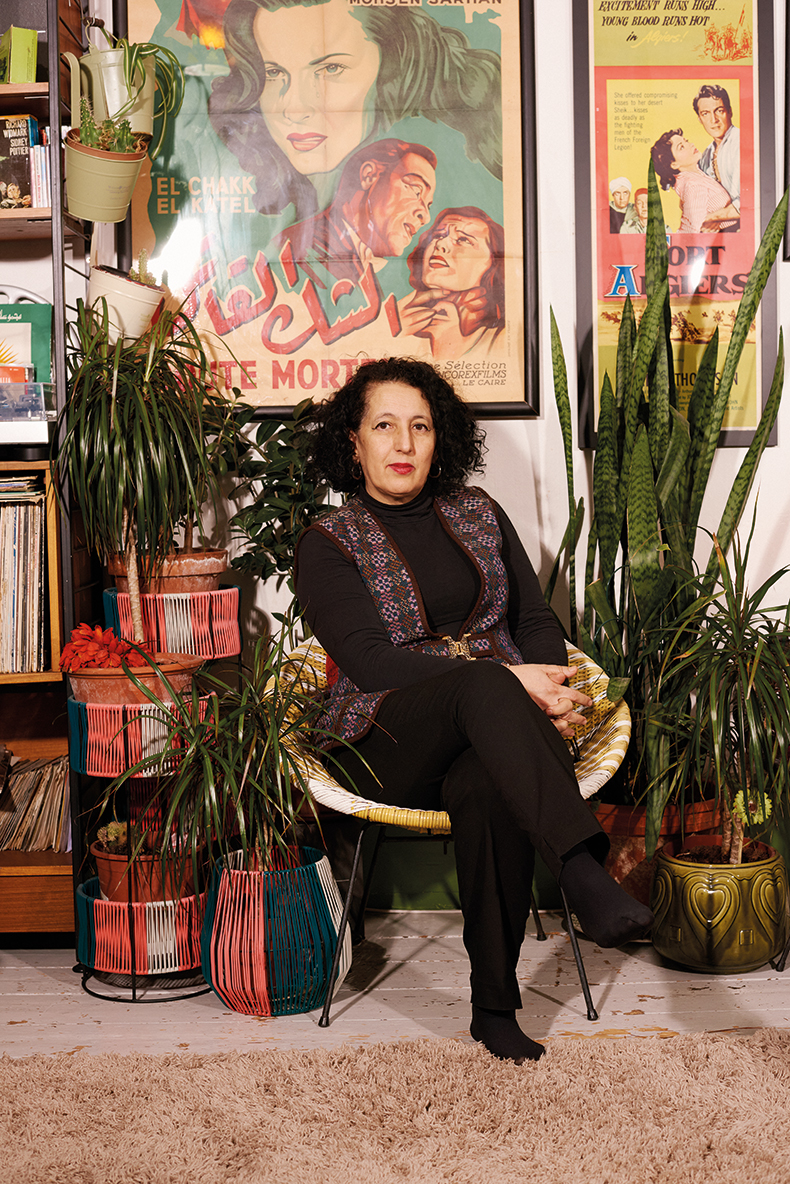
Photo: Toby Coulson
‘It was extremely important, for me, that it was a participatory project,’ she says. ‘People photographed themselves in the sets, they pretended to act, they danced. The film also had a lot of success because there is music, dancing and self-deprecation which people can relate to. All of the people in the film are friends and family – I think there is only one professional actor. And this was important because in the militant cinema era they had very little budget so they couldn’t hire professional actors – I wanted to play with that aesthetic but I also wanted to talk about the artistic, intellectual community and how important that is.’
Though Sedira’s research and interests are constantly evolving – she has ‘tons’ of negatives that she hasn’t used yet – she says she feels an instinctive pull towards the ’60s as not just the decade in which she was born, but also as an era of political consciousness. ‘The politics were awful in the ’60s, but people were starting to communicate with each other and come together. The world was on fire,’ she says. Does she think we can ever get back to that? ‘I don’t think so because it failed at the time but that doesn’t mean there was nothing good about it. We need to take a moment to actually look at all those political movements – there are things we can learn and adapt. You have to look into the past to move forward.’
From the February 2023 issue of Apollo. Preview and subscribe here.
Unlimited access from just $16 every 3 months
Subscribe to get unlimited and exclusive access to the top art stories, interviews and exhibition reviews.

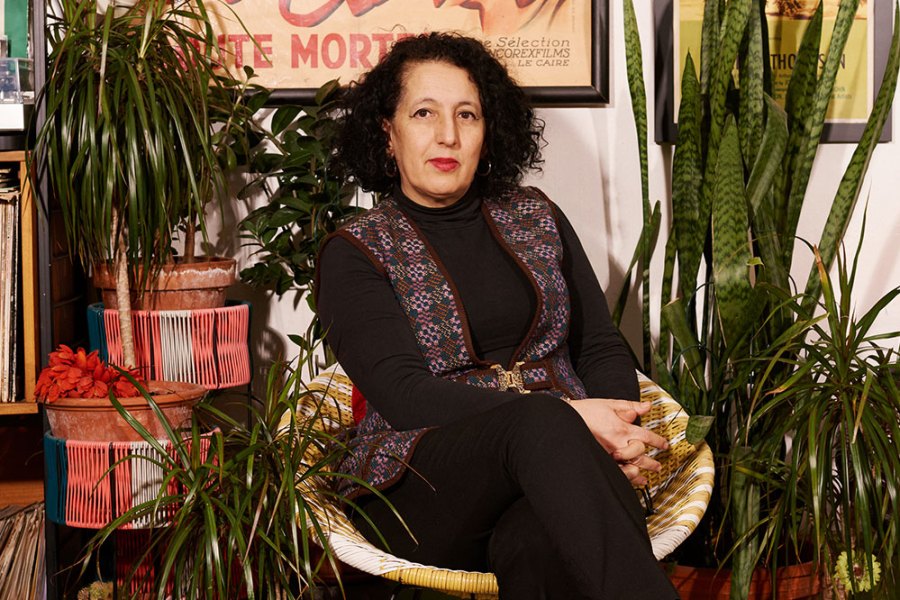
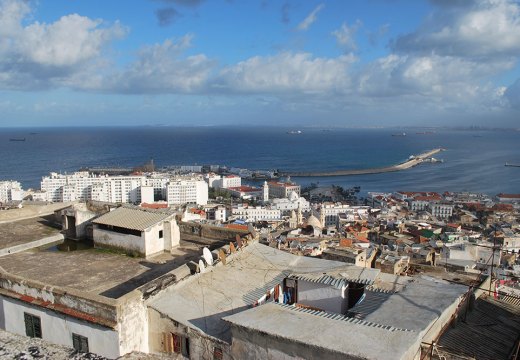
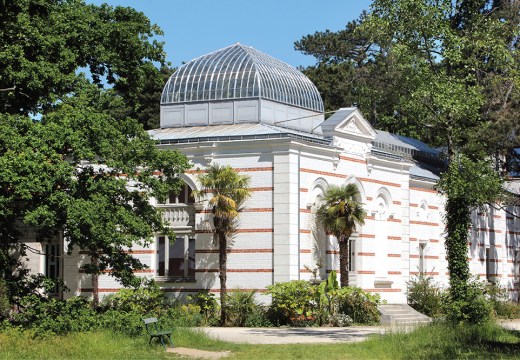
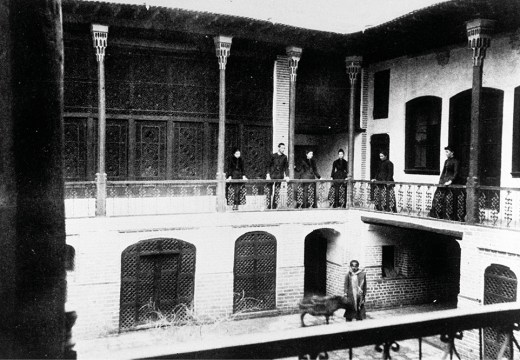









![Masterpiece [Re]discovery 2022. Photo: Ben Fisher Photography, courtesy of Masterpiece London](http://www.apollo-magazine.com/wp-content/uploads/2022/07/MPL2022_4263.jpg)
It’s time for the government of London to return to its rightful home